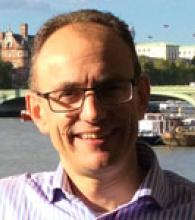PainRelief.com Interview with:
Joerg Steier PhD
Professor of Respiratory and Sleep Medicine
Guy’s & St. Thomas NHS Foundation Trust
King’s College London

PainRelief.com: What is the background for this study? Where is the TENS unit applied?
Response: Patients with obstructive sleep apnoea hold their breath at night, which fragments their sleep and leads to daytime symptoms like excessive daytime sleepiness. Keeping the tone of the neuromuscular structures, particularly the hypoglossal nerve and the genioglossus muscle, elevated at night using electrical current has become an established treatment over the last decade.
Hypoglossal nerve stimulation, however, is using an implantable device, is costly, and requires surgical intervention. The novelty in the current study is that using a transcutaneous electrical neurostimulator (TENS) that is placed underneath the chin in the submental area can achieve significant improvements sleep apnoea severity and associated symptoms as well.
PainRelief.com: What are the main findings?
Response: We have shown that in patients who are unable to tolerate firstline therapy, continuous positive airway pressure (CPAP), treatment with a TENS machine over a three month period significantly improves sleep apnoea severity and symptoms. This is the first time that this has been shown using this method, and it replicates the previous reports of shorter in-lab studies.
PainRelief.com: What should readers take away from your report?
Response: It is important to understand that obstructive sleep apnoea is fairly common, it is one of the most common respiratory conditions affecting about 1 bio people worldwide. There is evidence-based firstline treatment, CPAP, but this requires sleeping with a mask breathing pressurised air and ‘big data’ has provided the evidence that about 50% of patients using this treatment are non-adherent at 1-year follow up. It is therefore important to develop alternative treatment, second line therapies that work, and so far there were sparse options. A TENS machine could be affordable, safe, effective, and available in many healthcare settings for those patients who fail firstline therapy.
PainRelief.com: What recommendations do you have for future research as a result of this study?
Response: Thank you for the opportunity to elaborate on this. It is still important to identify responders to the treatment from non-responders. The location of the upper airway occlusion matters, similarly the neck circumference makes a difference. The larger the neck, the further the TENS machine will be away from the muscle and the nerve. In a previous study we have seen that women are more likely to be responders than men, likely due to a slimmer neckline.
Our group is also looking into potential favourable effects of this method on the blood pressure, and the autonomous nervous system. It is early days, but electrical stimulation is a potent intervention, and stimulating the submental area close to the carotides may provide other outcomes than the ones observed in sleep apnoea patients.
PainRelief.com: Is there anything else you would like to add? Any disclosures?
Response: We are planning to expand on the current study to assess the health economics in a multi-centre setting. In terms of disclosures, we have developed a patent with the intellectual property for the specific purpose of usage in sleep apnoea patients. We are still refining the stimulation algorithms, as they are further increasing efficacy of the treatment effect.
My employment organisation is starting to collaborate with industrial partners to develop a product that can be used incorporating all the required features. However, for the current trial we used nothing but an ‘over-the-counter’ device (TENS) and it is therefore encouraging to see that this was sufficient to achieve the reported results.
Citation: Domiciliary transcutaneous electrical stimulation in patients with obstructive sleep apnoea and limited adherence to continuous positive airway pressure therapy: a single-centre, open-label, randomised, controlled phase III trial
Deeban Ratneswaran, Michael Cheng, Ebrahim Nasser,Rajiv Madula, Martino Pengo, Kath Hope
Yuanming Luo, Georgios Kaltsakas, Michael I. Polkey, John Moxham Joerg Steie
Published:August 03, 2023DOI:https://doi.org/10.1016/j.eclinm.2023.102112
https://www.thelancet.com/journals/eclinm/article/PIIS2589-5370(23)00289-4/fulltext
The information on PainRelief.com is provided for educational purposes only, and is in no way intended to diagnose, cure, or treat any medical or other condition. Always seek the advice of your physician or other qualified health and ask your doctor any questions you may have regarding a medical condition. In addition to all other limitations and disclaimers in this agreement, service provider and its third party providers disclaim any liability or loss in connection with the content provided on this website.
Last Updated on August 4, 2023 by PainRelief.com
